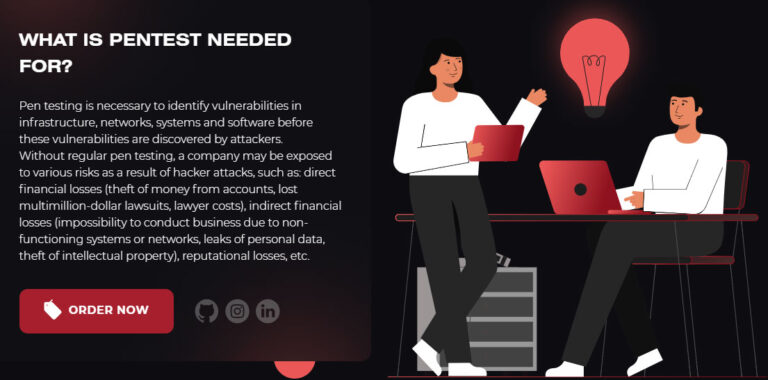In today’s interconnected world, where digital threats lurk around every virtual corner, safeguarding your digital assets is paramount. Cybersecurity breaches can lead to devastating consequences, ranging from financial losses to irreparable damage to your company’s reputation. In this context, penetration testing (Pentest), often referred to as pentesting, emerges as a crucial practice to fortify your defenses against malicious actors.
What is Penetration Testing?
Penetration testing, or pentesting, is a proactive approach to cybersecurity. It involves simulating the actions of a potential hacker to identify vulnerabilities within your information systems. Unlike real hackers who exploit weaknesses with malicious intent, penetration testers, or pentesters, undertake these activities with the sole purpose of enhancing your system’s security.
Why is Penetration Testing Needed?
The necessity for penetration testing arises from the dynamic nature of cybersecurity threats. Without regular assessments, organizations remain vulnerable to various risks posed by cyber attacks, including financial losses, reputational damage, and regulatory penalties. By conducting penetration tests, businesses can detect vulnerabilities before malicious actors exploit them, thereby minimizing potential damages.
Penetration Testing as a Service (PTaaS)
Penetration Testing as a Service (PTaaS) offers a comprehensive solution for businesses seeking to bolster their cybersecurity posture. This service involves a structured approach to identifying vulnerabilities and assessing the security of both external and internal information systems. Let’s delve into the steps involved in PTaaS:
1. Penetration Test Initiation
The process begins with the signing of non-disclosure agreements (NDAs) and agreements to establish the legal framework. This stage also entails defining the goals, timelines, and scope of the penetration testing, along with determining the testing method (white-box, gray-box, or black-box).
2. Reconnaissance and OSINT
During this phase, the PTaaS provider collects and analyzes information from online sources, including search engines, social networks, and forums. This reconnaissance helps in identifying potential attack vectors and gathering essential data for subsequent testing phases.
3. Threat Modeling
Threat modeling involves identifying targets and potential attack vectors based on the information gathered during reconnaissance. This stage also includes the use of automatic scanning tools to analyze vulnerabilities and plan further actions.
4. Exploitation
In the exploitation phase, the PTaaS provider validates vulnerabilities and simulates real attacks to assess the system’s resilience. This may involve attacks on web applications, networks, Wi-Fi, social engineering, or exploiting zero-day vulnerabilities.
5. Risk Analysis, Recommendations, Clearing Traces
Following the penetration testing, a comprehensive risk analysis is conducted to assess the severity of vulnerabilities. The PTaaS provider then offers recommendations to mitigate identified risks and clears traces of testing activities from the system.
6. Report
Finally, a detailed report is provided to the client, outlining the methods used, evidence gathered, steps to reproduce vulnerabilities, and recommendations for improving the security posture. This report serves as a valuable resource for enhancing the organization’s security defenses.
Conclusion
In an era characterized by escalating cyber threats, investing in robust cybersecurity measures is imperative for businesses of all sizes. Penetration Testing as a Service (PTaaS) offers a proactive approach to identifying and mitigating vulnerabilities, thereby safeguarding your digital assets against potential cyber attacks. By partnering with reputable PTaaS providers like CQR Company, businesses can stay one step ahead of malicious actors and ensure the integrity and confidentiality of their sensitive information.
Learn more about Pentest as a Service

0 Comments